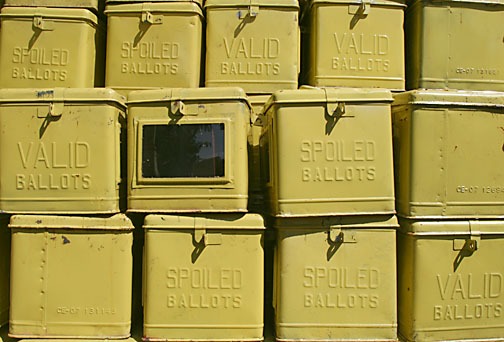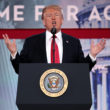It has now become clear that the efforts of Donald Trump and his supporters to overturn the 2020 elections were a multi-front attack.
The newest revelations have further detailed the scheme devised by conservative lawyer John Eastman to convince Vice President Pence to overturn the election results on January 6, 2021, the day the House and Senate were scheduled to convene a joint session to certify the election results.
As revealed in Bob Woodward and Bob Costa’s new book Peril, and more recently confirmed by Eastman himself, Eastman met with Trump and Pence on January 4 and laid out a roadmap for Pence to subvert the Constitution and declare Trump the winner. Eastman urged Pence to exclude the electoral votes of any states in which there were disputes over electors. Pence refused to take that path advocated by Trump and Eastman, and consistent with the Constitution, presided over the counting of the electoral votes of every state and declared Joe Biden the President.
Eastman’s efforts ultimately led nowhere. But another plot, discussed by the senior officials of the Department of Justice in the same period, while also never implemented, provided a step-by-step blueprint not only for 2020 but for future constitutional coups by legislatures in states under full partisan Republican control, enabling them to change the results of the popular vote.
That plan, drafted by the then-number three at Justice, Jeffrey Bossert Clark, Assistant Attorney General for the Environment and Natural Resources Division, amounts to a road map for the current and future efforts by Trump and his Republican allies to ensure that he, or another Republican, secures the presidency in 2024 regardless of who wins the popular vote or the true Electoral College vote.
In a December 27 phone call to Acting Attorney General Jeffrey Rosen, Trump demanded that the Acting Attorney General and the Acting Deputy Attorney General Richard Donoghue overturn the results of the 2020 election – or risk losing their jobs. “Just say that the election was corrupt + leave the rest to me and the R. Congressmen,” Trump said on the call, according to handwritten notes taken by Donoghue. The next day, December 28, Clark laid out his step-by-step plan to overturn the election results in a draft five-page letter along with an email he sent to Donoghue and Rosen. Clark asked them to sign the letter in order to send to the legislatures and governors of Georgia and “other relevant states,” requesting that they convene immediately, declare the results of the election void, and appoint presidential electors supporting Trump before the January 6 certification deadline.
The unprecedented Clark letter is more than an important historical document. It is the smoking gun evidence of Trump’s effort to force the Justice Department to overturn the election in 2020. Even more dangerously, it is a guide to how state legislatures can set aside the will of the people in 2024, and substitute their own choice for President, if voter suppression tactics and gerrymandering prove insufficient to get the result they seek.
Clark’s writings rely on a radical interpretation of the Constitution and Supreme Court precedent to effect a Constitutional coup. His ideas are based on language in Article II, Section 1, Clause 2 of the Constitution, which gives state legislatures sole authority to set the terms for how presidential electors are chosen, and thus determine the winner.
This concept is known as the Independent State Legislature Doctrine, established in an 1892 Supreme Court case, McPherson v. Blacker, which decided that even after a legislature has granted voters the ability to choose Presidential electors in that state on the basis of who has received the most votes, legislatures remain free to take back that power for themselves at any time.
This position was expressly reiterated by the Supreme Court in Bush v. Gore, the five-to-four decision in 2000 in which the conservative bloc on the Court handed George W. Bush the presidency, a ruling the Clark letter cites, though with important caveats that Clark ignores. Clark cites McPherson to justify the unlimited and unreviewable exercise by state legislatures of their right to decide on their states electoral votes at any time—even after the popular vote has taken place, regardless of the state’s constitution, courts, and voters.
If taken to its logical conclusion, this doctrine would remove the authority of Governors and Secretaries of State to certify Presidential elections based on the popular vote. It would enable state legislatures to ignore those officials, even when existing state law gives them the specific authority to make such certifications. The popular vote could be ignored so long as the legislature avoided violating the “equal protection” concerns articulated in Bush v. Gore.
Under the Clark interpretation of the Independent State Legislature doctrine, decisions by a state legislature to appoint Presidential electors are non-reviewable by judges. They could not be overturned by the finding of the state’s judiciary that the legislature has behaved improperly, possibly not even by the Supreme Court, since the state legislature’s authority under Article II to do this is “plenary,” or unlimited. This interpretation of the Constitution would allow for no check against any legislature’s determination to award its electoral votes to whichever candidate it wished, so long as it is careful to avoid creating a record that it was doing so in derogation of the rights of any particular voting group, such as on the basis of race or color, as precluded by the 15th Amendment. Instead, a legislature can simply make a finding that it has the authority to decide the winner on the grounds that, for example, purported fraud has made it impossible to determine the true popular winner selected by the state’s voters.
Clark’s email and draft letter described each step needed to apply this doctrine to award the electoral votes of Georgia and other swing states to Trump. First, the Justice Department would cite the reports by Republican legislators that found the state’s November elections to be “untrustworthy.” Second, the Justice Department would recommend that the legislature be called back into session “to determine the proper Electors to be certified to the Electoral College in the 2020 presidential race.” Third, the legislature would provide an alternative slate of electors–left unstated but assumed by Clark is that these would each be for Trump—to be signed, sealed and certified, and sent to the U.S. Senate and the Vice President by January 6 as required by the 12th Amendment.
A few state legislatures undertook halting steps in this direction in 2020 but none were completed, though Georgia went the furthest in an effort stopped in its tracks by the decision of Republican Secretary of State, Brad Raffensperger to re-certify the vote for Biden December 7, 2020 and to refuse to allow it to be reopened further.
According to a six-page memo written by Eastman on January 3, the day before he met with Trump and Pence, Republican electors for Trump did in fact secretly meet on December 14 to conduct a “trial run” of a variation on the Clark scheme in seven states (Arizona, Georgia, Michigan, Nevada, New Mexico, Pennsylvania, Wisconsin) and actually sent Pence alternative slates of Trump electors.
Since none of the state legislatures actually completed the steps to throw out the Presidential results based on the choices made by the state’s voters, any electoral votes such rogue electors might have sought to cast would have had no Constitutional basis. Republican-controlled state legislatures could overcome this defect in 2024 by acting promptly to shout “fraud” right after the elections, and then act to invalidate the popular vote and legislate their own partisan alternative.
Clark did not specify which states he meant when he stipulated that the legislatures of “each relevant state” should convene to determine which candidate should be awarded those states’ electoral votes. But the answer is apparent. In 2020, Republicans controlled both chambers of the state legislatures in Arizona (11 Electoral Votes), Georgia (16 EVs), Michigan (16 EVs), Pennsylvania (20 EVs), and Wisconsin (10 EVs). Had those legislatures awarded electoral votes to Trump instead of Biden and those legislative certifications been determined to be the only valid ones by the Supreme Court under the Independent State Legislature doctrine, the results of the 2020 election would have been neatly reversed. Instead of 306 EVs for Biden, and 232 EVs for Trump, the result would magically have become 305 EVs for Trump, and 233 EVs for Biden, thereby giving Trump the numerical “landslide” he demanded.
Here we should recall the concurrence in Bush v. Gore of a minority of the members of the Supreme Court (Justices Rehnquist, Scalia, and Thomas), emphasizing the importance of the language in McPherson on the powers of the state legislators over the selection of Presidential electors. In this concurrence, Rehnquist stated that the language of Article II, Section 1, Clause 2 “’convey[s] the broadest power of determination’ and ‘leaves it to the legislature exclusively to define the method’ of appointment” of electoral votes for President. For that reason, these three Justices found that state legislators, not state courts, were ultimately the decisionmakers on the award of the electoral votes in any state.
Notably, McPherson dealt with the authority of state legislatures to set rules governing electoral vote choices in laws enacted before the election took place, addressing whether a state could choose ahead of the voting to have electoral votes selected by the legislature itself, by popular vote state-wide, or by congressional district. McPherson did not cover a situation in which a legislature decided to change the rules after an election was concluded because those controlling the legislature did not like the result.
The federal law governing the process for the counting of electoral votes, the Electoral Count Act, limits the period for state legislative action on controversies over electors to six days before the electors are supposed to cast their votes. That date in 2020 was December 8. But under the Clark/Eastman reasoning, any provision in the Electoral Count Act purporting to limit what state legislatures can do is unconstitutional, and has no legal effect. Thus, regardless of the procedural requirements of the Electoral Count Act, a state legislature, according to Clark/Eastman, could make its choice on Presidential electors whenever and however it pleases, any time up to the counting of the votes specified under the 12th Amendment.
One basis for the Supreme Court to disallow any post-election action by a legislature to change the Presidential outcome chosen by the state’s voters would be Equal Protection, an issue that was at the core of the Supreme Court’s ruling in Bush v. Gore that halted the vote counting in Florida’s Broward County and thereby determined the election of George W. Bush over Al Gore. There the Supreme Court found that once a state legislature had vested the right to vote for President in its people, it must give “equal weight accorded to each vote” and “equal dignity owed to each voter.” The decision further stated that “[h]aving once granted the right to vote on equal terms, the State may not, by later arbitrary and disparate treatment, value one person’s vote over that of another,” citing the proposition that “once the franchise is granted to the electorate, lines may not be drawn which are inconsistent with the Equal Protection Clause of the Fourteenth Amendment.”
That language would seem to preclude a legislature from changing a state’s law to make its own ruling on electoral vote after the election has taken, because it would not be giving equal weight to each vote, but selecting the results on the basis of raw power.
But there is other language in the Bush v. Gore decision that counters this principle: “The State, of course, after granting the franchise [to its voters] in the special context of Article II, can take back the power to appoint electors. . . there is no doubt of the right of the legislature to resume the power at any time, for it can neither be taken away nor abdicated.” This language could be twisted to support the proposition that Equal Protection would not apply if the legislature takes the franchise for Presidential votes away from all of its voters and asserts its right to appoint Presidential Electors directly, even if the result would be to choose as electors those favoring the candidate who had already lost the popular vote in the state, thereby not giving equal weight or dignity to each vote in practice.
Given the stakes and the further politicization of the judiciary, it is entirely possible the Supreme Court would choose to stay out of the role of deciding which electoral votes should be deemed valid in a Presidential election. It could find that decisions on the recognition of electoral votes must be solely determined by Congress under the 12th Amendment.
In 2020, this outcome would have provided a cover for handing the Presidency to Trump. In a contested-vote scenario, the House and the Senate would likely have failed to agree on whether to respect either these states’ earlier certifications for Biden, or the later ones for Trump submitted by those states’ legislatures.
Under the 12th Amendment, if there is a disagreement between the House and Senate, the certification process goes to the House, where states vote on a state-by-state basis, one vote per state delegation. Whichever party controls a state’s Congressional delegation, controls the state’s vote. This arithmetic currently gives the advantage to Republicans, who control a majority of the 50 states House delegations due to gerrymandering and their dominance in states with smaller populations. In 2020, if the House had held a state-by-state canvass, voting based on the partisan tilt would have selected Donald Trump.
Seventy minutes after Clark sent his draft letter to Acting Attorney General Rosen and Acting Deputy Attorney General Donoghue, Donoghue replied to reject every aspect of what Clark had recommended,. He cited former Attorney General William Barr as having already expressly found there was no basis for believing that fraud had affected the outcome of the Presidential election. On January 2, Rosen sent a brief concurring cover note, stating that he was again confirming he would not sign on to Clark’s coup plan.
But there was even more in Clark’s plans. As he provided a road-map for overturning the results of the election, he also laid out an agenda to deploy Presidential emergency powers against anyone and everyone who might be accused by any conspiracy monger that they were somehow “complicit” with foreign governments to engage in election fraud. This was the perverse revenge part of the coup plan for the investigations into the Russian influence in the 2016 campaign to assist Trump’s election.
In his December 28 cover note to Rosen and Donoghue, claiming information from online “white hat hackers,” Clark called for a classified briefing from then Director of National Intelligence John Radcliffe, a far right Trump appointee, on “foreign election interference issues.” His purpose was to establish a basis, even a secret one, for Trump to activate Presidential Emergency Powers under the International Emergency Powers Act and Executive Order 13848, which authorizes the President to freeze and seize the assets of anyone who “directly or indirectly” engages in, sponsors, conceals, or otherwise is “complicit” in foreign interference in a United States election, or provides technological support for such activities.
Clark’s email stated that these unnamed hackers had put “evidence (in the public domain)” that a machine manufactured by Dominion Voting Systems accessed the Internet through a “smart thermostat with a net connection trail leading back to China.” The Chinese-thermostat theory which was among a host of false claims launched about Dominion’s voting machines was one being pushed by conspiracy-theorist and Overstock.com founder Patrick Byrne, the ultra-right wing news agencies NewsMax and the One America News Network, both of whom have since been sued by Dominion for promoting lies about the company.
If the White House had acted under this conspiracy-based part of the Clark plan, the President could have made unilateral findings of “fact” designating, for instance, Dominion, the Government of China, or depending on the day and conspiracy theorist, Venezuela and Cuba, mysterious entities supposedly based in Germany or Spain, and anyone else allegedly involved in foreign interference in the elections as the subjects of sanctions.
Such an order could have stipulated the freezing of all of their assets—in the case of Dominion, for example, any voting equipment and software owned by the company. By executive order, President Trump could have prohibited any U.S. person, including Dominion’s own U.S. employees, from engaging in any transactions with the company, including receiving their paychecks, in the same way they would be prohibited from transactions involving terrorists. One can hope that even courts packed with conservative judges would have found any such use of emergency powers to be a gross case of Presidential overreach. But in such a situation, one can imagine millions of Americans assuming the worst of the other side, and civil conflict spreading far beyond the insurrection that took place in the Capitol on January 6.
The coup doctrine enunciated by Clark remains alive. To date, there has been no reporting on whom he was working with in the Trump campaign, the Trump White House or beyond to develop it. Nor has any Congressional committee yet secured Clark’s testimony to gather those facts. Similar gaps remain regarding the coordination of Eastman’s activities, and how Eastman got connected to Trump. Since the elections, we have seen a coordinated nationwide strategy by which Republican-controlled state legislatures have been enacting election laws to give themselves greater control over the outcomes.
These new laws begin with voter suppression provisions to make it difficult for Democratic-leaning constituencies to vote. They also introduce new controls to allow partisan state legislatures to maintain control over elections to give Republicans greater control of vote-counting processes; reduce the authority of governors and secretaries of state to exercise independent judgment about who has won the popular vote in the state; and potentially even move certification dates to enable the legislature to invalidate a governor’s certification after the fact.
The Republicans pushing this scheme on a national basis characterize their actions as entirely proper under the Independent State Legislature doctrine. But what the country now faces looking forward to in 2024 is a highly partisan Supreme Court that could accept the plan laid out by Clark, enabling partisan state legislatures to decide Presidential elections in what should rightly be called “Legislative Nullification.” Nullification has a long and disgraced historical lineage, from nullification of federal tariffs (South Carolina in the 1830s), to federal desegregation orders (Arkansas in the 1950s), to health care policy (Texas in 2020). This latest nullification scheme aims at nullifying democracy itself.
Jonathan Winer is a Washington lawyer who previously served as the State Department’s senior official for international law enforcement, and a member of Keep Our Republic, a group focused on protecting American democracy.







0 Comments